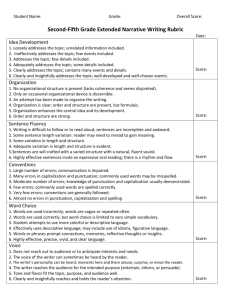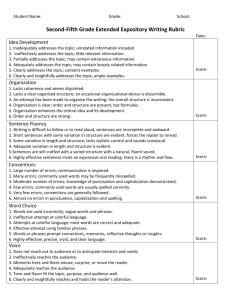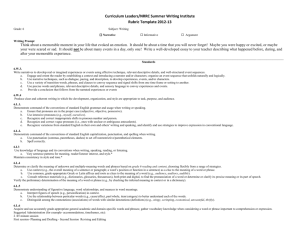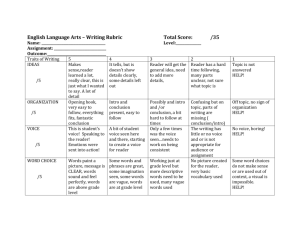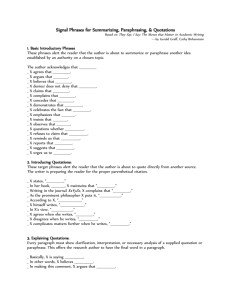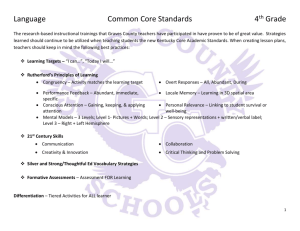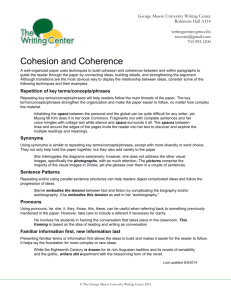Narrative - Salem State University
advertisement
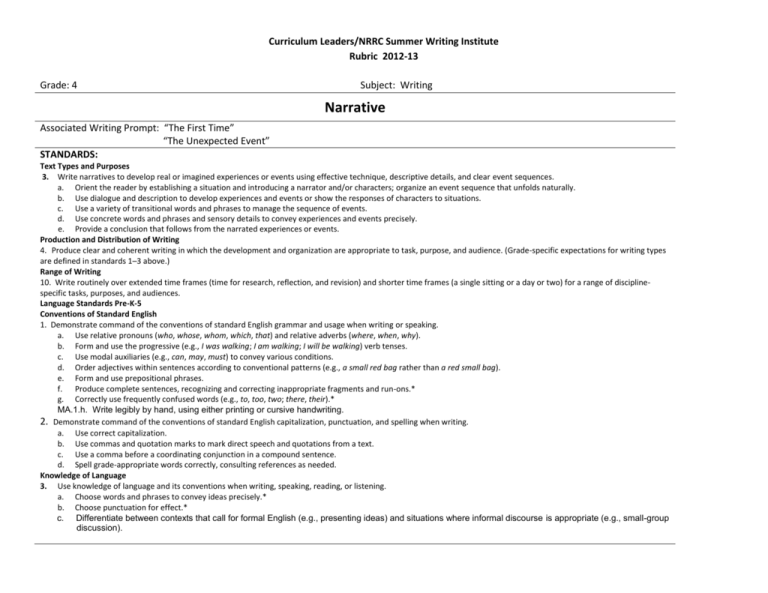
Curriculum Leaders/NRRC Summer Writing Institute Rubric 2012-13 Grade: 4 Subject: Writing Narrative Associated Writing Prompt: “The First Time” “The Unexpected Event” STANDARDS: Text Types and Purposes 3. Write narratives to develop real or imagined experiences or events using effective technique, descriptive details, and clear event sequences. a. Orient the reader by establishing a situation and introducing a narrator and/or characters; organize an event sequence that unfolds naturally. b. Use dialogue and description to develop experiences and events or show the responses of characters to situations. c. Use a variety of transitional words and phrases to manage the sequence of events. d. Use concrete words and phrases and sensory details to convey experiences and events precisely. e. Provide a conclusion that follows from the narrated experiences or events. Production and Distribution of Writing 4. Produce clear and coherent writing in which the development and organization are appropriate to task, purpose, and audience. (Grade-specific expectations for writing types are defined in standards 1–3 above.) Range of Writing 10. Write routinely over extended time frames (time for research, reflection, and revision) and shorter time frames (a single sitting or a day or two) for a range of disciplinespecific tasks, purposes, and audiences. Language Standards Pre-K-5 Conventions of Standard English 1. Demonstrate command of the conventions of standard English grammar and usage when writing or speaking. a. Use relative pronouns (who, whose, whom, which, that) and relative adverbs (where, when, why). b. Form and use the progressive (e.g., I was walking; I am walking; I will be walking) verb tenses. c. Use modal auxiliaries (e.g., can, may, must) to convey various conditions. d. Order adjectives within sentences according to conventional patterns (e.g., a small red bag rather than a red small bag). e. Form and use prepositional phrases. f. Produce complete sentences, recognizing and correcting inappropriate fragments and run-ons.* g. Correctly use frequently confused words (e.g., to, too, two; there, their).* MA.1.h. Write legibly by hand, using either printing or cursive handwriting. 2. Demonstrate command of the conventions of standard English capitalization, punctuation, and spelling when writing. a. Use correct capitalization. b. Use commas and quotation marks to mark direct speech and quotations from a text. c. Use a comma before a coordinating conjunction in a compound sentence. d. Spell grade-appropriate words correctly, consulting references as needed. Knowledge of Language 3. Use knowledge of language and its conventions when writing, speaking, reading, or listening. a. Choose words and phrases to convey ideas precisely.* b. Choose punctuation for effect.* c. Differentiate between contexts that call for formal English (e.g., presenting ideas) and situations where informal discourse is appropriate (e.g., small-group discussion). NARRATIVE WRITING RUBRIC Grade 4 Trait (4) Strong/Exceeding Effectively develops real or imagined (3) Meeting/Developed Develops real or imagined experiences (2) Developing/Emerging Begins to develop real or imagined (1) Beginning/Rudimentary Main idea not evident Ideas experiences or events with descriptive detail Situation and introduction of a narrator and/or characters is clearly established and unfolds naturally Uses carefully chosen and effective dialogue and description to develop experiences and events to show the response of characters to situations or events (topic) with descriptive detail Situation and introduction of a narrator and/or characters is clearly established Correctly uses dialogue and description to develop experiences and events to show the response of characters to situations experiences or events with descriptive words (main idea underdeveloped or too broad) Situation and introduction of a narrator and/or characters is unclear Begins to use dialogue and description to develop experiences and events to show the response of characters to situations but not effectively Writing is unfocused and topic is not developed Details do not support the development of experiences and events or show the response of characters to situation •Uses interesting/creative techniques to draw the reader into the piece (ex. opening/lead) •Events are carefully sequenced to unfold naturally and a wide variety of transitional words and phrases are used to manage the sequence of events •Provides a thoughtful and interesting conclusion that follows from the narrated experiences or events •Uses effective techniques to draw the reader into the piece (ex. opening/lead) •Events are sequenced to unfold naturally and a variety of transitional words and phrases are used to manage the sequence of events •Provides a thoughtful conclusion that follows from the narrated experiences or events •Attempts to use techniques to draw the reader into the piece (ex. opening/lead) •Some events are sequenced to unfold naturally and a variety of transitional words and phrases are used to manage the sequence of events •Provides a conclusion but is ineffective, too familiar, or does not follow from the narrated experiences or events •Does not effectively use techniques to draw the reader into the piece (ex. opening/lead) • Events are not sequenced to unfold naturally and a very few or repetitive transitional words and phrases are used to manage the sequence of events •Does not provide a conclusion •Includes evidence of writer’s personality and style and begs to be read aloud •Writer thoughtfully creates a personal connection with the reader •Voice is consistently appropriate for the purpose, audience, topic, and/or genre •Consistently includes carefully chosen precise words and phrases and sensory details to convey meaning precisely including similes and/or metaphors •Words are consistent with audience and purpose •Writer avoids overused words and includes a variety of words to convey meaning •Includes evidence of writer’s personality and style •Reader feels a personal connection with the writer •Voice is mostly appropriate for the purpose, audience, topic, and/or genre •Begins to show evidence of writer’s personality and style •Reader occasionally feels a connection with the writer •Voice is somewhat appropriate for the purpose, audience, topic, and/or genre •No evidence of writer’s personality •Reader feels no connection with the writer •Voice is not appropriate for the purpose and audience •Uses some concrete words and phrases and sensory details to convey meaning including similes and metaphors •Words are mostly appropriate for audience and purpose •Mostly avoids overused words •Begins to use some concrete words and phrases and sensory details to convey meaning including similes and metaphors •Some words may not be appropriate for audience and purpose •Includes some overused words •Includes a limited range of words often used incorrectly • Words are not appropriate for audience and purpose •Includes many overused words Organization Voice Word Choice Fluency Conventions •Creatively uses variety of simple, compound, & complex sentences •Creatively uses a variety of sentence types (exclamatory, interrogative, imperative, declarative) •Includes all complete sentences relative to the length of the piece •Includes many varied sentence beginnings purposefully for effect •Has no errors in grade level appropriate grammar •Has no errors in grade level appropriate punctuation and capitalization •Has no errors in grade level conventional spelling See Language 1&2 •Includes a variety of simple, compound, & complex sentences •Includes a variety of sentence types (exclamatory, interrogative, imperative, declarative) •Includes a few incomplete sentences relative to the length of the piece •Includes many varied sentence beginnings •Has few errors in grade level appropriate grammar •Has few errors in grade level appropriate punctuation and capitalization •Has few errors in grade level conventional spelling See Language 1&2 •Includes some variety of simple, compound, & complex sentences •Includes some variety of sentence types (exclamatory, interrogative, imperative, declarative) •Includes some incomplete sentences relative to the length of the piece •Includes some varied sentence beginnings •Has some errors in grade level appropriate grammar •Has some errors in grade level appropriate punctuation and capitalization •Has some errors in grade level conventional spelling See Language 1&2 •Includes limited use of simple, compound, & complex sentences •Includes limited use of sentence types (exclamatory, interrogative, imperative, declarative) •Includes many incomplete sentences relative to the length of the piece •Includes few or no varied sentence beginnings •Has multiple errors in grade level appropriate grammar •Has multiple errors in grade level appropriate punctuation and capitalization •Has multiple errors in grade level conventional spelling See Language 1&2
